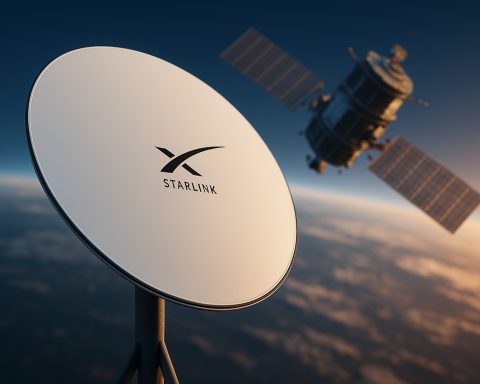- China is at the forefront of revolutionizing the automotive industry with electric vehicles (EVs), integrating AI and autonomous driving.
- Xpeng’s launch of the advanced X9 minivan at the Shanghai Auto Show highlights the transition from electrification to “smartification.”
- Despite innovation, profitability remains uncertain in the tech-driven EV sector.
- BYD exemplifies success with 4.2 million units sold globally and $5.5 billion in profit, highlighting the benefits of diversified strategies.
- Companies like Chery, Geely, Leapmotor, and Li Auto show diverse approaches, from transitioning from gasoline to electric, to focusing on affordable and premium models.
- Battery innovation by CATL is crucial for cost reduction and increased EV range, aiming for better profitability.
- The EV narrative in China is a transformative journey towards sustainability, showcasing human ambition and innovation.
The dusty roar of traditional gasoline engines is being challenged by a silent, yet irresistible, revolution. As China accelerates into the future, it has planted its flag firmly in the electric vehicle (EV) landscape, poised to redefine mobility as we know it. Yet, amidst the fervor of innovation, the question looms: who will withstand the relentless pressure of this high-stakes competition?
Venture into the heart of the Shanghai Auto Show, and you might find yourself surrounded by a spectacle of innovation that evokes visions of the future. Chinese automaker Xpeng captivated audiences with its futuristic X9 minivan, a marvel equipped with automated driving capabilities and screens designed to enthrall backseat passengers. It’s a vehicle that signifies a shift from mere electrification to “smartification.”
This transformative tide is buoyed by the integration of artificial intelligence and autonomous driving technologies, allowing companies like Xpeng to stake their claim in this evolving arena. However, beneath their polished exteriors and revolutionary features, a stark reality emerges: the profitability of these tech-driven ventures remains in question. Industry leaders recognize both the immense potential and the formidable hurdles inherent in these groundbreaking endeavors.
Established in Shenzhen, BYD, China’s automotive juggernaut, offers a contrast. With a staggering 4.2 million units sold globally and a record profit of $5.5 billion last year, BYD exemplifies the fruits of diversified offerings and strategic acumen. Their triumph serves as a blueprint for success in an arena fraught with volatility, yet also brimming with untapped potential.
Other players in this epic saga include the likes of Chery and Geely, veterans of the Chinese market who have seamlessly transitioned from gasoline to electric vehicles. Meanwhile, Leapmotor and Li Auto carve their niches by focusing on affordable models and premium hybrids, respectively. These strategies underscore the diverse approaches within the industry as companies vie for dominance.
An interesting twist in this tale of innovation is the role of Chinese battery giant CATL. By advancing battery technology, CATL aims to cut costs, reduce weight, and extend the range of electric vehicles, potentially easing the path to profitability for many EV manufacturers.
As the clangor of competition crescendos, the stakes have never been higher. Whether the promise of robotaxis and humanoid helpers from tech visionaries like Xpeng will translate into sustainable success remains to be seen. Yet, one certainty prevails: the nations leading this charge are sculpting the future of transportation and, alongside it, a global revolution. This drive towards a new era reflects not just China’s ambitions, but humanity’s collective journey towards a more sustainable tomorrow.
Ultimately, the electric vehicle saga in China is not merely a narrative of machines and profit margins. It’s a story of ambition and resilience, of daring greatly and the pursuit of a future that, once imagined, is now swiftly becoming reality.
Is China’s Electric Vehicle Revolution the Ultimate Game Changer?
The Evolution of Electric Vehicles in China
As China surges ahead in the electric vehicle (EV) sector, it is not just spearheading an automotive revolution but fundamentally reshaping global transportation dynamics. Chinese automakers like Xpeng, BYD, and Geely are at the forefront, pushing boundaries with innovative technology and strategic growth.
Key Insights You Need to Know
1. China’s EV Market Dynamics
– Market Growth: China is the largest EV market globally, driven by aggressive government policies, investment in infrastructure, and booming domestic demand. According to BloombergNEF, more than 50% of global EV sales by 2025 could be attributed to China.
– Policy Support: Chinese government subsidies and incentives have played a pivotal role in reducing the cost of EVs, making them more accessible to consumers.
2. Technological Innovations
– AI and Automation: Xpeng’s X9 minivan showcases advancements in autonomous driving and in-car entertainment systems, setting a new standard for “smart” vehicles.
– Battery Advancements: Companies like CATL have made significant strides in battery technology, focusing on creating more efficient and longer-lasting batteries, which are crucial for reducing costs and extending driving range.
Reviews & Comparisons
– BYD vs. Xpeng: BYD’s strategy of diversified vehicles, including buses, cars, and even rail systems, has resulted in robust profitability. In contrast, Xpeng focuses on leading-edge technology and autonomous features, targeting tech-savvy demographics.
– Leapmotor vs. Li Auto: Leapmotor targets the mass market with affordable EV models, while Li Auto focuses on premium hybrid vehicles appealing to more affluent customers.
Controversies & Limitations
– Profitability Challenges: Despite technological triumphs, many Chinese EV startups still struggle with achieving sustainable profitability. High competition and significant R&D investment pose financial risks.
– Infrastructure Concerns: Even though EV sales are growing, the development of charging infrastructure still needs to keep pace to support widespread adoption.
Industry Trends & Predictions
– Global Impact: Analysts predict that as China continues to innovate and reduce costs, its influence on the global EV market will grow. Countries worldwide may adopt similar policies to accelerate their EV transition.
– Market Consolidation: With fierce competition, mergers, and acquisitions are likely as companies seek to consolidate strength and leverage economies of scale.
How-To Steps for Aspiring EV Buyers in China
1. Research: Understand different EV models and their ranges, costs, and features.
2. Incentives: Look for government subsidies or incentives that may reduce purchase costs.
3. Test Drive: Compare different models by taking test drives to assess performance and comfort.
4. Home Charging Setup: Consult with professionals to set up home charging stations for convenience.
Quick Tips for Automakers Entering the EV Sector
– Strategic Partnerships: Collaborate with battery producers and technology firms like CATL to boost innovation.
– Focus on UX: Design user-friendly interfaces and advanced in-car technology to enhance customer satisfaction.
– Sustainability Measures: Incorporate sustainability into manufacturing processes to appeal to eco-conscious consumers.
Conclusion
China’s electric vehicle sector is more than an assemblage of cutting-edge technology and marketing prowess; it is the nexus of a broader socio-economic transition towards sustainability. For more information about automaker innovations and market trends, please visit the BYD and Xpeng main pages.
By understanding these dynamics and leveraging emerging trends, automakers and consumers alike can navigate this transformative landscape effectively.







